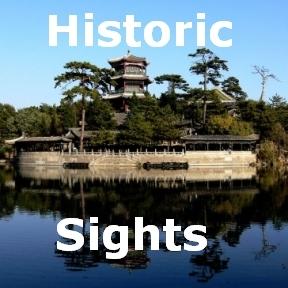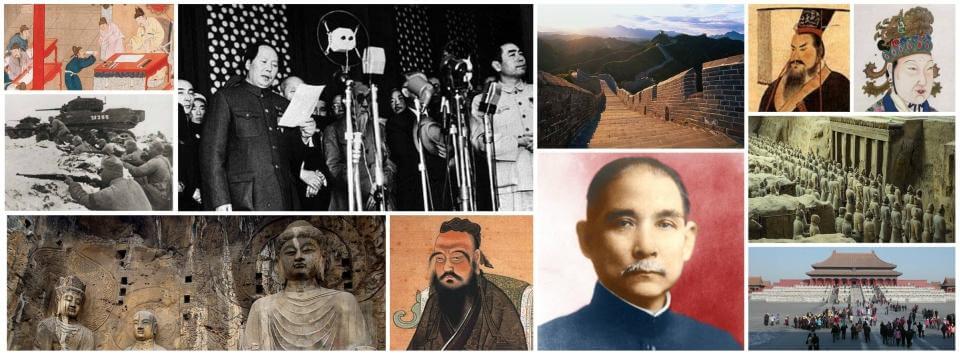
Kuaiji Mountain Scenic Area
The information contained here are subject to change. Chinese History Digest is not responsible or liable if any changes should occur.
Opening Hours
8am - 5pm
Entrance Ticket Prices
50 yuan
Free for children under 1.2m and half price for children between 1.2m and 1.5m
Shaoxing in Zhejiang province is one of the places in China that should be on the itinerary of every traveler that is interested in Chinese history. The two most famous historic sights of this mid-sized city lie on its outskirts. These are the Orchid Pavilion Garden (a.k.a. Lanting Pavilion) which is also featured on this website and the Kuaiji Mountain Scenic Area. Inside the latter are several noteworthy historic sights such as the Yu Temple and the Mausoleum of Yu the Great.
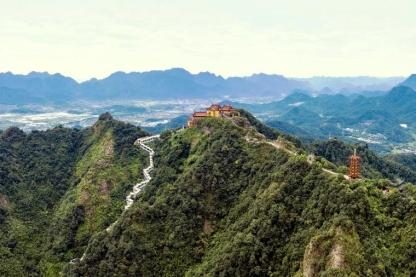 Lufeng Temple buildings on top of Shaoxing's Mount XiangluIn the distant historic past, Shaoxing was known as Kuaiji. The Kuaiji Mountain Scenic Area is located about six kilometers southeast of Shaoxing's center. The Kuaiji Mountain (Kuàijī Shān in Chinese) at the center of this verdant area is interchangeably also known under other names such as Huiji Mountain. Out of its several peaks, Mount Xianglu (Xiānglú Fēng = "Incense Burner Peak") is the highest with an elevation of 354.7 meters. It is so named due to its peculiar shape.
Lufeng Temple buildings on top of Shaoxing's Mount XiangluIn the distant historic past, Shaoxing was known as Kuaiji. The Kuaiji Mountain Scenic Area is located about six kilometers southeast of Shaoxing's center. The Kuaiji Mountain (Kuàijī Shān in Chinese) at the center of this verdant area is interchangeably also known under other names such as Huiji Mountain. Out of its several peaks, Mount Xianglu (Xiānglú Fēng = "Incense Burner Peak") is the highest with an elevation of 354.7 meters. It is so named due to its peculiar shape.
The name of Yu the Great (Da Yu in Chinese), the founder and mythical ruler of the Xia dynasty, is inextricably linked to the Kuaiji Mountain in more ways than just one. About 4,000 years ago, Yu the Great is believed to have worked on the implementation of flood-control measures in the area that is now Shaoxing. He also reportedly got married there and the Kuaiji Mountain even got its name from an old legend that speaks of Yu rewarding feudal lords according to their merits in controlling the flood at this spot. (In Chinese, kuaiji means to "reward people according to their merits".) Yu then suddenly died from an illness during a hunting tour in the area and was subsequently buried at the foot of the mountain where the Mausoleum of Yu the Great (a.k.a. Dayu Mausoleum or Dayuling in Chinese) now stands.
This mausoleum is however just one of many sights at the Kuaiji Mountain Scenic Area which holds a 4A (AAAA) rating in China's Ministry of Culture and Tourism's tourist attraction rating system since 2005. When visiting the scenic area, these are the sights that are included in the ticket price:
- Visitor Center
- Jiulong Altar (Nine Dragon Altar) water fountain
- Da Yu Memorial Hall
- Lufeng Temple on Mount Xianglu
- Jiyu Square and the Jiyu Pavilion
- Great Yu Statue on Shifan Hill
- Yu Temple
- Mausoleum of Yu the Great (a.k.a. Dayu Mausoleum)
- Yu Clan Temple
- Paradise of Birds (a.k.a. Baiyingyuan)
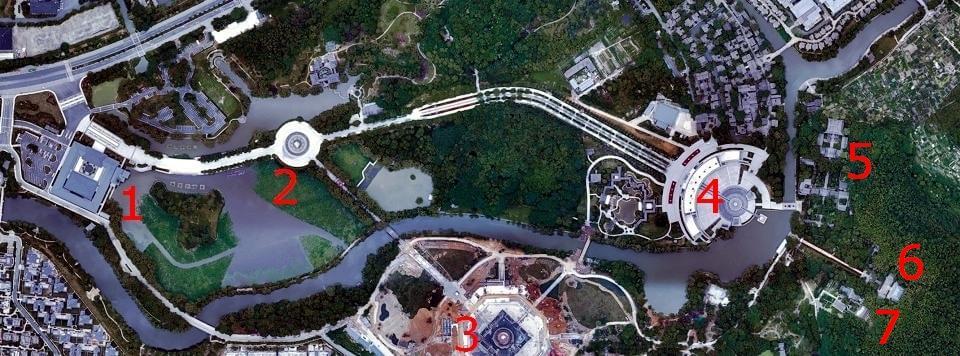 partial aerial overview of the Kuaiji Mountain Scenic Area showing the location of the following sights: 1. Visitor Center, 2. Jiulong Altar, 3. Da Yu Memorial Hall, 4. Jiyu Square, 5. Yu Temple, 6. Mausoleum of Yu the Great, 7. Yu Clan Temple
partial aerial overview of the Kuaiji Mountain Scenic Area showing the location of the following sights: 1. Visitor Center, 2. Jiulong Altar, 3. Da Yu Memorial Hall, 4. Jiyu Square, 5. Yu Temple, 6. Mausoleum of Yu the Great, 7. Yu Clan Temple
There is a large stone entrance gate at the main entrance of the Kuaiji Mountain Scenic Area. After passing through it, visitors will come to a modern Visitor Center (see number 1 on the above map). After parking their cars in the large parking lot in front of it, visitors can then begin their exploration of the entire scenic area. To save time and energy, there are electric shuttles available that will take visitors close to various scenic spots throughout the vast area. On their way to the newly-built Da Yu Memorial Hall (number 3 on the above map), visitors will pass by the Jiulong Altar fountain (number 2 on the above map) which in recent years had its diameter (38 meters) and height (6 meters) increased.
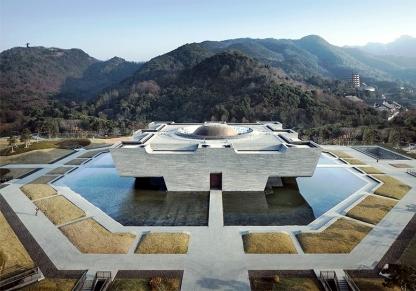 view of the modern Da Yu Memorial HallThe Da Yu Memorial Hall is a modern museum that was opened in late 2020. Its architectural style was chosen to resemble the shape of ancient Chinese ritual cauldrons that are known as ding. Whereas a central meditation hall occupies most of the space of the building's ground level, four different exhibition areas can be found on the underground floor. There is a 3D cinema in one of these four areas and the other three respectively inform visitors about the history of the Xia dynasty, how Yu the Great tamed the floods and how successive generations maintained the practice of offering ritual sacrifices to him.
view of the modern Da Yu Memorial HallThe Da Yu Memorial Hall is a modern museum that was opened in late 2020. Its architectural style was chosen to resemble the shape of ancient Chinese ritual cauldrons that are known as ding. Whereas a central meditation hall occupies most of the space of the building's ground level, four different exhibition areas can be found on the underground floor. There is a 3D cinema in one of these four areas and the other three respectively inform visitors about the history of the Xia dynasty, how Yu the Great tamed the floods and how successive generations maintained the practice of offering ritual sacrifices to him.
About 800 meters south of the Da Yu Memorial Hall lies the entrance of a large temple area. It is also the spot from where tourists can climb up the mountain all the way to the top of Mount Xianglu. The Buddhist Temple whose buildings occupy a large area at the foot of the mountain as well as on the peak of Mount Xianglu was known under a variety of names in its history. Since it was rebuilt in 1990, the temple is known as the Lufeng Temple and the calligraphic inscription with that name is attributed to Zhao Puchu who was then the president of the Buddhist Association of China and one of the most renowned Chinese calligraphers. Lufeng Temple is an active Buddhist temple with several dozen monks living there in permanent residence. More than 20,000 square meters of its total area of about 67,000 square meters are occupied with various constructed structures.
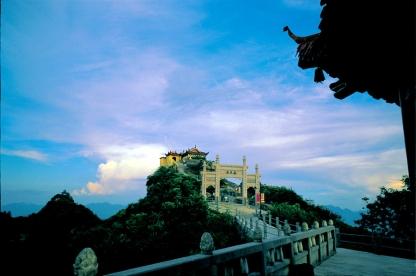 walkway approaching the Lufeng Temple buildings on Mount XiangluThe temple's most important halls at the foot of Mount Xianglu are the Shanmen Hall, Tianwang Hall, Daxiong Hall and Baoen Hall. To reach the temple buildings on the peak of Mount Xianglu, visitors will need about an hour to climb the steep stone steps that lead there. Besides the Guanyin Hall and the Sansheng Buddha Hall for prayer and sacrifice, there is also a beautiful large pagoda on top of Mount Xianglu. Large rocks with Buddhist inscriptions can be found near the temple buildings. On clear-sky days, you will be able to enjoy beautiful and far-reaching views over the city of Shaoxing from the top of the mountain. On many days of the year, the peak of Mount Xianglu - the Incense Burner Peak - is however shrouded in mist which can be charming in its own unique way!
walkway approaching the Lufeng Temple buildings on Mount XiangluThe temple's most important halls at the foot of Mount Xianglu are the Shanmen Hall, Tianwang Hall, Daxiong Hall and Baoen Hall. To reach the temple buildings on the peak of Mount Xianglu, visitors will need about an hour to climb the steep stone steps that lead there. Besides the Guanyin Hall and the Sansheng Buddha Hall for prayer and sacrifice, there is also a beautiful large pagoda on top of Mount Xianglu. Large rocks with Buddhist inscriptions can be found near the temple buildings. On clear-sky days, you will be able to enjoy beautiful and far-reaching views over the city of Shaoxing from the top of the mountain. On many days of the year, the peak of Mount Xianglu - the Incense Burner Peak - is however shrouded in mist which can be charming in its own unique way!
It is recorded in the sixth chapter of the Basic Annals of Sima Qian's Records of the Grand Historian, that the Qin dynasty emperor Qin Shi Huang climbed the Kuaiji Mountain in order to offer sacrifices to Yu the Great in 210 BC, the 37th and last year of his reign. The emperors and officials of the succeeding Han dynasty then continued the practice of making sacrifices to Yu at the mountain. The Mausoleum of Yu the Great and the Yu Temple were built on the northern slopes of the mountain during the period of the Southern dynasties in the 6th century AD. Many kings and emperors, officials and noblemen offered their sacrifices to Yu there in the centuries that followed and so did Yu's descendants as well as common people.
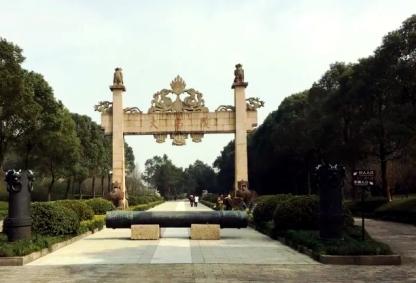 Longgang bronze pillar in front of stone gateway with Jiang Zemin's calligraphic inscriptionThe practice of offering sacrifices to Yu the Great at the Kuaiji Mountain even continued after the fall of China's last imperial dynasty and only came to a temporary end in 1949, the year when the People's Republic of China was founded. China's communist leaders then allowed ceremonies to resume in 1995, at first on a small scale. The "Ritual Ceremony for the Great Yu" was then upgraded to a national ceremony in 2007 and is nowadays regarded as a part of the country's intangible cultural heritage. The ceremony is held in April every year at the Kuaiji Mountain Scenic Area. A special ceremonial square was built for it in 2003 right next to the Dayu Mausoleum and Yu Temple. This square which is now known as Jiyu Square (number 4 on the above map) was expanded and renovated in 2020. It now gives up to 10,000 visitors the opportunity to witness and take part in the ceremony that includes ritual elements as well as music and dance performances.
Longgang bronze pillar in front of stone gateway with Jiang Zemin's calligraphic inscriptionThe practice of offering sacrifices to Yu the Great at the Kuaiji Mountain even continued after the fall of China's last imperial dynasty and only came to a temporary end in 1949, the year when the People's Republic of China was founded. China's communist leaders then allowed ceremonies to resume in 1995, at first on a small scale. The "Ritual Ceremony for the Great Yu" was then upgraded to a national ceremony in 2007 and is nowadays regarded as a part of the country's intangible cultural heritage. The ceremony is held in April every year at the Kuaiji Mountain Scenic Area. A special ceremonial square was built for it in 2003 right next to the Dayu Mausoleum and Yu Temple. This square which is now known as Jiyu Square (number 4 on the above map) was expanded and renovated in 2020. It now gives up to 10,000 visitors the opportunity to witness and take part in the ceremony that includes ritual elements as well as music and dance performances.
Since its award-winning expansion and renovation were completed, Jiyu Square is now regarded as a tourist attraction in its own right, especially by fans of modern architecture. When walking towards the square on Yuling Road from the west, visitors will see a large stone gateway that in 1995 had the three Chinese characters Da Yu Ling carved into it in the calligraphic style of China's former president Jiang Zemin. The horizontal bronze pillar that obstructs the passage in front of the memorial gateway was meant to remind visiting worshippers to get off their horses or out of their sedan chairs and walk the rest of the way as a gesture of respect to Yu the Great. The pillar is named Longgang (Dragon bar) and the vertical bronze posts on each side of it were used to tie up horses.
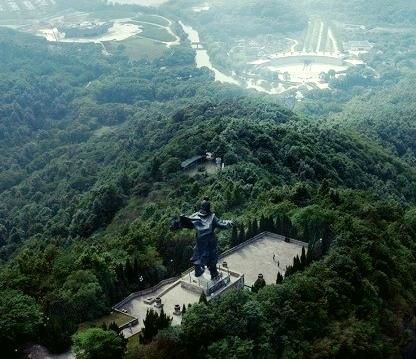 Great Yu Statue on Shifan Hill with the Da Yu Memorial Hall and Jiyu Square visible in the distanceTwelve pairs of divine stone animals that are meant to ward off evil spirits stand by the side of Yuling Road. The road leads directly to the modern Jiyu Pavilion which has a 10.9-meter-tall and 7.2-meter-wide bronze plaque attached to its western facade. The plaque displays the Chinese character "Yu" in honor of Yu the Great. Inside the pavilion are several rooms that are used when events are held at the venue such as a waiting room, rehearsal room, lounge and media release room. Nine bronze tripods stand on top of Jiyu Pavilion and its 92-meter-long and 6-meter-high eastern wall that faces the sacrificial square contains relief sculptures that tell stories about the life and achievements of Yu the Great.
Great Yu Statue on Shifan Hill with the Da Yu Memorial Hall and Jiyu Square visible in the distanceTwelve pairs of divine stone animals that are meant to ward off evil spirits stand by the side of Yuling Road. The road leads directly to the modern Jiyu Pavilion which has a 10.9-meter-tall and 7.2-meter-wide bronze plaque attached to its western facade. The plaque displays the Chinese character "Yu" in honor of Yu the Great. Inside the pavilion are several rooms that are used when events are held at the venue such as a waiting room, rehearsal room, lounge and media release room. Nine bronze tripods stand on top of Jiyu Pavilion and its 92-meter-long and 6-meter-high eastern wall that faces the sacrificial square contains relief sculptures that tell stories about the life and achievements of Yu the Great.
A bell and a drum pavilion stand on the other side of Jiyu Square. In between them, there is a walkway that leads to a water altar amidst Yu Pond. The altar is positioned directly opposite the Divine Road that leads up to the Mausoleum of Yu the Great on the other side of the pond. Also in a direct line of sight but high up on top of Shifan Hill in the distance stands the 21-meter-tall Great Yu Statue that was erected in 2001. The statue is made of bronze and weighs 118 tons. It can be reached on foot in about an hour and great views reward the visitors that made the effort to climb the thousands of stairs that lead there.
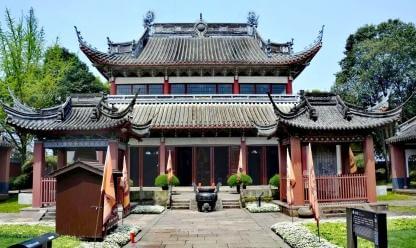 view of the Main Hall of the Yu TempleJust about a hundred meters to the east of Jiyu Square lies the Yu Temple (number 5 on the above map) which was originally built in AD 545 during the period of the Southern dynasties. Most of its existing structures date from the time of the Qing dynasty. The design and symmetrical layout of the Yu Temple in many ways resemble traditional Chinese palatial architecture like that of the Forbidden City in Beijing. From south to north, visitors will come to the Screen Wall, the Goulou Stele Pavilion, the Meridian Gate, the Sacrificial Hall and the Main Hall.
view of the Main Hall of the Yu TempleJust about a hundred meters to the east of Jiyu Square lies the Yu Temple (number 5 on the above map) which was originally built in AD 545 during the period of the Southern dynasties. Most of its existing structures date from the time of the Qing dynasty. The design and symmetrical layout of the Yu Temple in many ways resemble traditional Chinese palatial architecture like that of the Forbidden City in Beijing. From south to north, visitors will come to the Screen Wall, the Goulou Stele Pavilion, the Meridian Gate, the Sacrificial Hall and the Main Hall.
The Goulou Stele Pavilion in front of the Meridian Gate protects an ancient stele that is said to date from the time when Yu carried out the flood-control measures in the area. The 77 ancient characters on this Goulou Stele are generally believed to tell the story of how Yu tamed the floods. However, there is some dispute among scholars on this issue and the ancient nature of these characters makes any translation effort guesswork to some degree. The earliest form of Chinese writing that can be translated with a high level of accuracy dates from the time of the Shang dynasty. This dynasty succeeded the Xia dynasty that Yu the Great is believed to have founded.
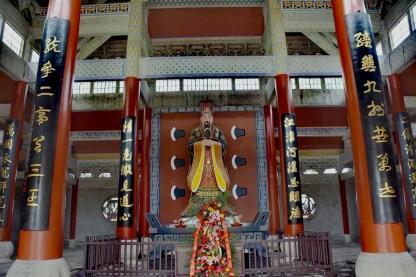 altar with a statue of Yu the Great inside the Main Hall of the Yu TempleThe Sacrificial Hall behind the Meridian Gate is where ritual offerings were made to Yu the Great in ancient times. These sacrificial offerings included animals such as pigs, cows and goats which were butchered in a house outside the temple. This Butcher's House is the building to the left of the temple's entrance that is now used as a temporary exhibition hall. The 24-meter-tall double-eaved Main Hall of the Yu Temple stands on an elevated terrace at the northern extremity of the temple grounds. The rebuilding of this hall occurred in 1933 when China was already a republic. It contains an altar with a painted statue of Yu the Great wearing his kingly garb and headdress. The statue is a modern recreation since its original predecessor was destroyed during the tumultuous time of the Cultural Revolution. The fresco painting on the side wall of the Main Hall dates from modern times as well.
altar with a statue of Yu the Great inside the Main Hall of the Yu TempleThe Sacrificial Hall behind the Meridian Gate is where ritual offerings were made to Yu the Great in ancient times. These sacrificial offerings included animals such as pigs, cows and goats which were butchered in a house outside the temple. This Butcher's House is the building to the left of the temple's entrance that is now used as a temporary exhibition hall. The 24-meter-tall double-eaved Main Hall of the Yu Temple stands on an elevated terrace at the northern extremity of the temple grounds. The rebuilding of this hall occurred in 1933 when China was already a republic. It contains an altar with a painted statue of Yu the Great wearing his kingly garb and headdress. The statue is a modern recreation since its original predecessor was destroyed during the tumultuous time of the Cultural Revolution. The fresco painting on the side wall of the Main Hall dates from modern times as well.
The octagonal stone pavilion on the left side of the Main Hall of the Yu Temple contains an odd cone-shaped stone that has inscriptions in various fonts on it. The stone that is known as "Zhishi Ting" is about two meters tall and has a round hole near the top. It is believed that this was a burial stone that was used during Yu's burial ceremony. It is impossible to determine whether that was the case or not since the oldest inscriptions on it date from the time of the Han dynasty. At the side of the Yu Temple, visitors will find a natural spring. The Feiyin Spring maintains its flow throughout the year and its clear water forms a small pool that has a mythical stone-carved beast inside of it. The nearby cliff carving of the name of the spring dates from the time of the Song dynasty and the stele that stands in the Feiyinquan Pavilion tells the story of how the spring was restored thanks to the donation of 100,000 yuan by private donors.
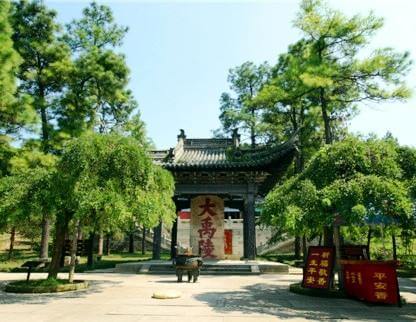 view of the Stele Pavilion at the Mausoleum of Yu the GreatThe Mausoleum of Yu the Great (number 6 on the above map) is located to the southeast of the Yu Temple about one-third up the slope of Yuwang Hill. Old Chinese scholar trees, pines and bamboo groves surround the mausoleum structures. After having climbed up the stone steps that lead straight up the hill, visitors will first approach the Stele Pavilion which was last rebuilt in 1979. Underneath this pavilion lies the "Yu Cave" where Yu the Great is believed to have been buried. The Stele Pavilion protects a 4.05-meter-tall and 1.9-meter-wide stele that had the three big characters Da Yu Ling written on it by Nan Daji, the prefect of Shaoxing during the Jiajing period (AD 1521 - AD 1567) of the Ming dynasty. Unfortunately, the ancient stele was broken into two pieces when a powerful typhoon passed over the area in the autumn of 1956. Steel bars and mortar hold the two fragmented pieces together since the stele was re-erected in October 1961.
view of the Stele Pavilion at the Mausoleum of Yu the GreatThe Mausoleum of Yu the Great (number 6 on the above map) is located to the southeast of the Yu Temple about one-third up the slope of Yuwang Hill. Old Chinese scholar trees, pines and bamboo groves surround the mausoleum structures. After having climbed up the stone steps that lead straight up the hill, visitors will first approach the Stele Pavilion which was last rebuilt in 1979. Underneath this pavilion lies the "Yu Cave" where Yu the Great is believed to have been buried. The Stele Pavilion protects a 4.05-meter-tall and 1.9-meter-wide stele that had the three big characters Da Yu Ling written on it by Nan Daji, the prefect of Shaoxing during the Jiajing period (AD 1521 - AD 1567) of the Ming dynasty. Unfortunately, the ancient stele was broken into two pieces when a powerful typhoon passed over the area in the autumn of 1956. Steel bars and mortar hold the two fragmented pieces together since the stele was re-erected in October 1961.
When worship ceremonies for Yu the Great were held at his tomb in ancient times, musicians would play music from the Xianruo Pavilion right next to the Stele Pavilion. This octagonal stone pavilion with double eaves was built in AD 1164 during the Southern Song period. Right next to the Xianruo Pavilion, visitors will see a Stele Corridor. It was assembled in the 1980s by putting the steles that were scattered throughout the area together. The steles that were carved during various ancient dynasties bear inscriptions that are related to the history of the place. Many of the steles that are assembled here even hold a special place in the history of Chinese calligraphy.
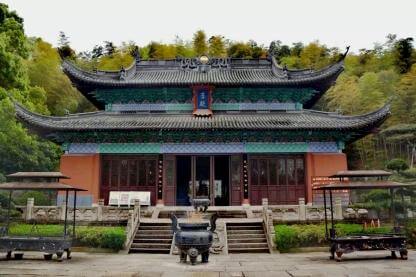 view of the Dayu Mausoleum's rebuilt Sacrificial HallThe large Sacrificial Hall higher up on Yuwang Hill behind the Stele Pavilion was rebuilt in November 2007 in its original historic style. The 43 sacrificial vessels in front of the hall's altar are arranged according to the ancient Tailao banquet ritual and the large-scale colored paintings on the hall's side walls celebrate Yu's achievements in water management and the establishment of the Xia dynasty. The exhibits at the two auxiliary halls next to the large Sacrificial Hall further illustrate and explain the ancient sacrificial rituals that were held at the Mausoleum of Yu the Great during dynastic times.
view of the Dayu Mausoleum's rebuilt Sacrificial HallThe large Sacrificial Hall higher up on Yuwang Hill behind the Stele Pavilion was rebuilt in November 2007 in its original historic style. The 43 sacrificial vessels in front of the hall's altar are arranged according to the ancient Tailao banquet ritual and the large-scale colored paintings on the hall's side walls celebrate Yu's achievements in water management and the establishment of the Xia dynasty. The exhibits at the two auxiliary halls next to the large Sacrificial Hall further illustrate and explain the ancient sacrificial rituals that were held at the Mausoleum of Yu the Great during dynastic times.
About 50 meters south of the Mausoleum of Yu the Great lies another small temple. The west-facing temple consists of two halls (the front hall and the back hall) and a curved corridor. This is the Yu Clan Temple (number 7 on the above map) which was rebuilt in 1986 at its original location by the local Shaoxing government. Since then, it allows Yu's descendants of the Si family (Da Yu's family name was Si) to hold worshiping ceremonies for their famous ancestor there. Besides historical materials and a statue of Da Yu, visitors will find pictures of cultural relics that are related to Yu's water control measures inside the Yu Clan Temple. Included among the historical materials is the genealogy of the Shaoxing branch of the Si family.
Travelers that still have some energy left after visiting all the abovementioned sights can make the Paradise of Birds (Baiyingyuan) their last sightseeing stop for the day. This 30,000-square-meter bird park is located about 300 meters east of the Mausoleum of Yu the Great and admission to it is included in the ticket price to the Kuaiji Mountain Scenic Area. There are 10 different bird-watching areas within the park and shows are performed for the entertainment of visitors. Included among the roughly 10,000 birds of 130 different species that live inside this area are birds of prey, swans, parrots, ostriches and free-roaming peacocks.
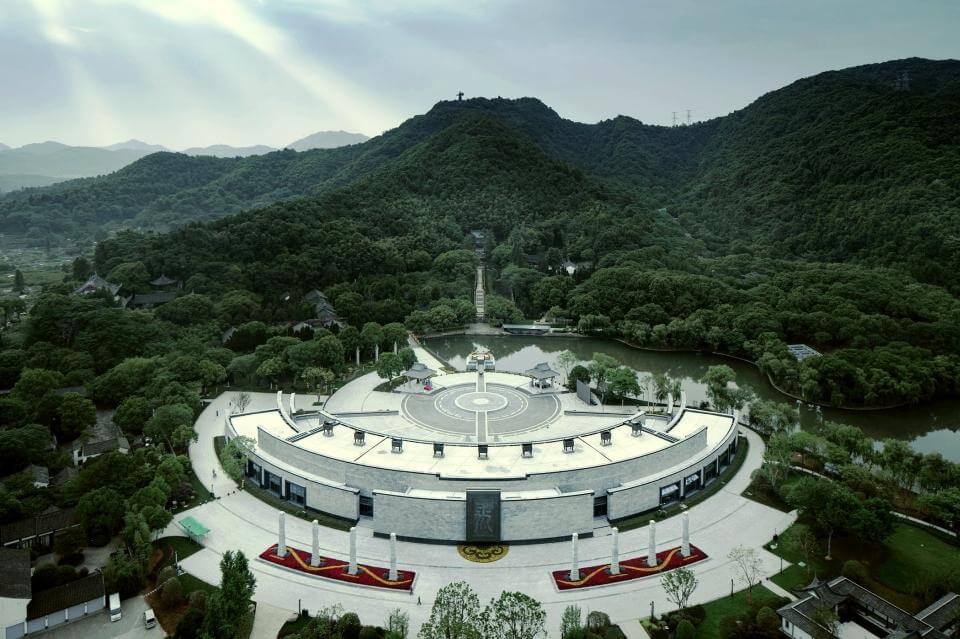 aerial view of the Jiyu Pavilion and Jiyu Square. From left to right behind it among the trees are the Yu Temple, Dayu Mausoleum and Yu Clan Temple and the Great Yu Statue is visible on Shifan Hill in the distance.
aerial view of the Jiyu Pavilion and Jiyu Square. From left to right behind it among the trees are the Yu Temple, Dayu Mausoleum and Yu Clan Temple and the Great Yu Statue is visible on Shifan Hill in the distance.
How to get to the Kuaiji Mountain Scenic Area?
| Address: | Kuaiji Mountain Scenic Area, 2nd Ring E Rd, Yuecheng District, Shaoxing, Zhejiang province, China |
| Tel.Nr.: | Mausoleum of Yu the Great: +86 575 8836 6666 Lufeng Temple: +86 575 8836 3511 |
| Airport: | Hangzhou Xiaoshan International Airport (HGH) |
| Train Station: | Shaoxing Railway Station |
| Bus: | Dayuling Station (bus lines: 2, 136) - From there, it is just a short walk to the entrance area for the Yu Temple and the Mausoleum of Yu the Great. |
On the following Google map, the blue icon at the center shows the approximate location of the main entrance area of the Kuaiji Mountain Scenic Area. The Yu Temple and the Mausoleum of Yu the Great lie about 1 km to the east of this entrance area. The two yellow hotel bed icons show the location of the Kuaiji Mountain Yangming Hotel (our recommended hotel near the Kuaiji Mountain Scenic Area) and the Shaoxing Xianheng Grand Hotel (our recommended hotel in downtown Shaoxing). Further below on this page, you can read a review of the services and amenities of both of these hotels. In case you are planning a trip to China, you could support this website by using the provided affiliate links to check prices and book your hotel accommodation!
You can book hotels in China with both of our affiliate partners Agoda and Trip.com. No matter whether you choose Agoda or Trip.com, you will find many offers on each of these platforms that will allow you to make a risk-free booking with the possibility of free cancellation until a clearly stated date and time, sometimes as late as the intended date of arrival. However, some deals require prepayment and don't permit cancellation without fees. In that case, the incurred cancellation fees are clearly stated.
When following an Agoda link, the search results will show you prices, availability and special offers for your chosen dates with the recommended hotel in the top search position as well as for other hotels in the same area. Links to Trip.com will take you to the specific hotel webpage where you can then search for availability, prices and special deals with your chosen dates.
The provided information was thoroughly researched from various hotel booking websites. Chinese History Digest is not responsible if any information regarding the provided services and amenities might have changed.
Recommended Hotel near the Mausoleum of Yu the Great
The Kuaiji Mountain Yangming Hotel that is reviewed below is located just a short drive away from the Mausoleum of Yu the Great. In addition to the links to Agoda that are used in the review below, this hotel is also available for booking on Trip.com by following this link.
Kuaiji Mountain Yangming Hotel
 The Kuaiji Mountain Yangming Hotel is a 5-star garden-style resort hotel that was opened in 2016 adjacent to the 18-hole golf course of the Kuijishan Golf Club (Tel.: +86 575 8860 9090). The hotel is not only popular with golfers though (since hotel guests can use the golf club's facilities) but also with families. Free parking as well as (paid) valet parking is of course available at the Kuaiji Mountain Yangming Hotel. Travelers that don't have a vehicle at their disposal can use the hotel's taxi booking service. The roughly 3-kilometer ride from the hotel to the entrance area of the Mausoleum of Yu the Great typically takes less than 10 minutes. The 11-kilometer drive to the Shaoxing Railway Station takes about half an hour and the nearest airport in Hangzhou (52km away) can be conveniently reached by shuttle bus in about 90 minutes (for a fare of only 30 yuan per person). Airport transfer services are therefore not provided by the hotel.
The Kuaiji Mountain Yangming Hotel is a 5-star garden-style resort hotel that was opened in 2016 adjacent to the 18-hole golf course of the Kuijishan Golf Club (Tel.: +86 575 8860 9090). The hotel is not only popular with golfers though (since hotel guests can use the golf club's facilities) but also with families. Free parking as well as (paid) valet parking is of course available at the Kuaiji Mountain Yangming Hotel. Travelers that don't have a vehicle at their disposal can use the hotel's taxi booking service. The roughly 3-kilometer ride from the hotel to the entrance area of the Mausoleum of Yu the Great typically takes less than 10 minutes. The 11-kilometer drive to the Shaoxing Railway Station takes about half an hour and the nearest airport in Hangzhou (52km away) can be conveniently reached by shuttle bus in about 90 minutes (for a fare of only 30 yuan per person). Airport transfer services are therefore not provided by the hotel.
The Kuaiji Mountain Yangming Hotel has a total of 139 rooms (including suites and family rooms), some of which provide special features such as a balcony, terrace or lake view. All rooms are air-conditioned and equipped with a sofa, refrigerator, cable TV, minibar and safe. Smoking is not permitted in the rooms or any of the indoor areas. Free bottled water as well as instant coffee and tea are provided and free internet access is available through both LAN and Wi-Fi. Laundry service (including dry cleaning) and luggage storage are available as well. The hotel has a restaurant and a lobby bar and a buffet breakfast (Western & Chinese food) is commonly included in the room rate (additional charge of 88 yuan if not included). Self-catering is also possible since there is a convenience store on site. For exercise, hotel guests have access to an indoor and outdoor swimming pool, a fitness center and a basketball court. There is also an area for playing billiards and table tennis and kids have their own kiddie pool and a play area outside.
1.7 miles away from the Dayu Mausoleum
Check availability & prices!Recommended Hotel near Shaoxing's city center
The Shaoxing Xianheng Grand Hotel that is reviewed below is perhaps the best hotel in downtown Shaoxing. It is also the closest 5-star hotel to the Orchid Pavilion Garden. The Mausoleum of Yu the Great meanwhile can be reached by taxi in just about 15 minutes. In addition to the links to Agoda that are used in the review below, this hotel is also available for booking on Trip.com by following this link.
Shaoxing Xianheng Grand Hotel
 The Shaoxing Xianheng Grand Hotel is a 5-star hotel at the heart of Shaoxing. When staying at this luxurious hotel, guests are just 1.5km away from the city center. There are also many restaurants (including a Starbucks) and historic places of interest in the immediate vicinity of this hotel such as the Former Residence of Qiu Jin and the Former Residence of Lu Xun. What's more, access to the historic neighborhoods around the Shaoxing Xianheng Grand Hotel is very convenient due to the availability of a shuttle service. Reaching the Hangzhou Xiaoshan International Airport from this hotel typically takes about 40 minutes and airport transfer is available upon request (for an additional fee). The Orchid Pavilion Garden on the outskirts of Shaoxing can be reached by public bus, taxi, rental car and even by bicycle as the road there is mostly flat. The hotel rents bicycles and can book rental cars as well.
The Shaoxing Xianheng Grand Hotel is a 5-star hotel at the heart of Shaoxing. When staying at this luxurious hotel, guests are just 1.5km away from the city center. There are also many restaurants (including a Starbucks) and historic places of interest in the immediate vicinity of this hotel such as the Former Residence of Qiu Jin and the Former Residence of Lu Xun. What's more, access to the historic neighborhoods around the Shaoxing Xianheng Grand Hotel is very convenient due to the availability of a shuttle service. Reaching the Hangzhou Xiaoshan International Airport from this hotel typically takes about 40 minutes and airport transfer is available upon request (for an additional fee). The Orchid Pavilion Garden on the outskirts of Shaoxing can be reached by public bus, taxi, rental car and even by bicycle as the road there is mostly flat. The hotel rents bicycles and can book rental cars as well.
All rooms at the Shaoxing Xianheng Grand Hotel are air-conditioned and internet access through Wi-Fi is free. Both smoking and non-smoking rooms are available upon request and the hotel also has suites. Each room has a minibar and a safe and complimentary instant coffee is provided. Laundry service (including dry cleaning) and luggage storage are available. There are altogether five restaurants and a bar on-site and a free buffet breakfast is included in the room rate. For exercise, guests have access to an indoor swimming pool, a fitness center, a yoga room and a room for playing table tennis and billiards. For relaxation, hotel guests can book a massage and use the hotel's sauna, steam room and spa.
3.4 miles away from the Dayu Mausoleum
Check availability & prices!